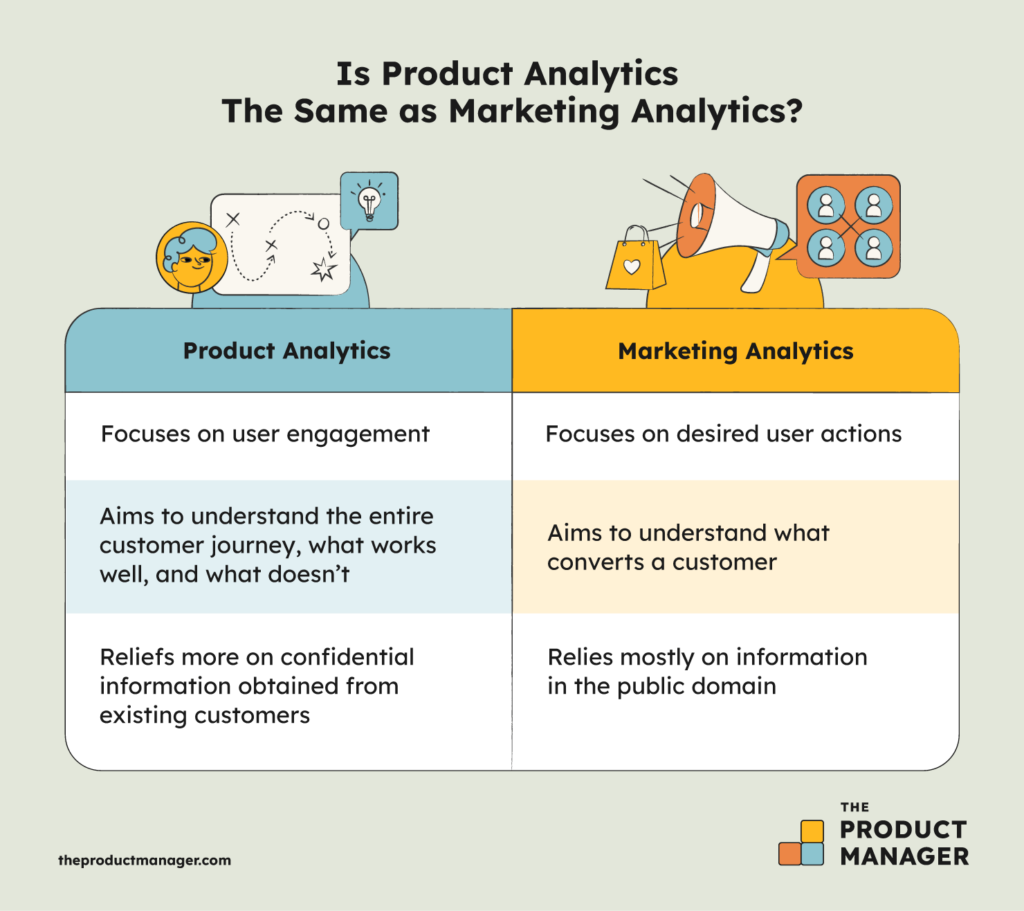Product analytics is integral for your product’s success. It can provide you with all the information you need to ensure your product resonates with your customers, including insights into how customers interact with your product, what features they like, what obstacles they run into, and when they turn away.
By analyzing data gathered this way, you can see what works for your customers and what doesn’t. Proper use of this data can help inform every part of your product management cycle.
Product analytics is vital in today’s marketing-heavy world to ensure that your product is as attractive as possible. You need to understand how product analytics works to know what you can do with it. From there, the tools product analytics provides can turn your product into a huge success.
Successful companies are turning to product analytics software to understand how their current and potential customers are interacting with their products and services. This guide will help you answer some of the leading questions in the product analytics area.
What is Product Analytics?
Product analytics is the process of understanding and answering questions related to customers' behaviors when they interact with your products. For the product manager and their team, product analytics provides useful data from which insights can be made.
Product analytics software tools use embedded sensors within digital products to track user actions, whether it features users spend the most time with, how often they return to your product, or the paths they take to conversion. Information gathered about user behavior is then used to identify shortcomings, optimize the product, and improve the user experience.
Product analytics is user-centric. Rather than focusing on what a product was designed to do, it is concerned with how users interact with the product. This helps the product manager to draw precise insights on what aspects of the product need improvement, rather than relying on guesswork and instinct alone.
Traditionally, product managers relied on questionnaires and customer interviews to determine the perceptions of customers and users of their products. Even though these methods allowed brands to understand how users interacted with their products, these techniques were expensive and time-consuming. Today, companies can discern these user interactions using a range of product analytics software tools available in the market.
Is Product Analytics the Same as Marketing Analytics?
Even though the phrases ‘product analytics’ and ‘marketing analytics’ are sometimes used as synonyms, this is not always the case. However, the two concepts are closely interlinked. Below are the main differences between the two concepts:

Ultimately, marketing analytics focuses on how to turn visitors into paying customers, while product analytics seeks ways for these customers to be engaged so that they will keep coming back to the product.
Why Is Product Analytics Important?
Product marketing has always had a luck element to it. No matter how many times you ask a customer what they like, what they want, and what they can’t stand, there’s always the chance they’ll turn around and do exactly what you don’t expect.
Gives Direction To Product Development And Design
Product analytics helps in product design abstraction. With the level of insight brought about by tracking user events, it is easier to know what customers use, and what they don’t. Your product can be made leaner, lighter, and faster by removing features that no one is using while retaining its most relevant ones.
Data analytics gives you hard data without emotional bias. You don’t have to spend your budget on advertising that you hope will work. Instead, use your insights to create better customer experiences and guide your users to the products you know to do well.
Builds Better Customer Relationships
As we progress in the digital age, people increasingly want a digital product experience. A personalized experience is not only appreciated—it’s expected.
The best way to give people what they want is through the use of product analytics. After all, how can you personalize an experience if you don’t know what your customers like?
When you listen to the data, your products become increasingly attractive to your customers. This is a stellar way of building customer loyalty by making a product that users simply can’t get enough of.
Who Benefits Most From Product Analytics?
Everybody involved in the creation process, marketing, and use of products, benefits from product analytics.
- The Product Manager: Uses data produced by product analytics to evaluate the experience of the users when using the product. Product managers also identify the product's weaknesses, and determine what needs to be done to improve the user experience.
- Developers and UX Designers: Are better able to find and resolve design and implementation flaws when they are aware of users’ experiences with the product. Designers can also learn which features confuse users and address them accordingly.
- Marketers: Are better able to sell a product to users if they know exactly what the users are doing with the product. Added to this, they can also determine what the users do with the marketing information they receive.
- Customers: Are always looking for products that are easy to use as it may not always be possible for customers to get their views across in the way their actions do. Thus, by knowing what behaviors customers exhibit when dealing with products, brands can discern what customers are looking for. This improves the customer experience.
How To Take Advantage Of Product Analytics?
Using product metrics to boost your sales and forge a more meaningful product experience might seem complicated, but the process is actually quite simple.
- Define your goals: Without a plan in mind, how can you know what data to collect? Start with an explicit action you can take with product analytics, such as lengthening user engagement or getting more people to register.
- Create a plan to track: Create a list of every event you need to follow that’s related to your goal. These events include leaving your page, signing in, or deleting an item from a cart.
- Choose the right product: There are several product analytics software options out there, and they all perform different tasks. Ideally, you’d have multiple platforms. However, if you can only use one, make sure you do your research and pick the right one.
Predictive Analytics
Predictive analytics uses real-time data to predict what a user will do. There are many ways to use predictive analytics.
- Predict interactions: You can use your collected data to predict your traffic for a specific day. For example, airlines use predictive analytics to set ticket prices.
- Reduce fraud: By detecting suspicious activity as it’s happening, predictive analytics can alert you to possible fraud or tell you when other cybersecurity issues arise.
- Risk mitigation: Predictive analytics can suggest when a customer might not meet their financial promises by assessing their creditworthiness.
A/B Testing
A/B testing is a method of evaluating what works on sites. Two options are created for a product or service. Then data is collected. Whichever performs better is the one the company goes with.
This is a simple yet effective way of using a data analytics tool to better understand how users work. It’s also a classic method of analytics that’s been used for decades.
Types of Product Analytics Metrics To Track
There’s no reason to gather and analyze every scrap of data you can get your hands on. Doing that only places tremendous pressure on your analytics team to make sense of it all.
Instead, pick the metrics that matter to you. Save yourself time and effort by narrowing down what you look at based on what your goals are. If you’re not sure where to start, here are some of the top metrics a product analyst looks at.
- Engagement: Think of the engagement metric as a map of a customer journey. You gather data about how customers got to you, what they did before signing up, which features they engaged with the most (and least), and what ultimately brings them back. This information allows you to tweak your product to optimize the customer journey for as many new customers as possible.
- Customer churn: Tracking this will tell you when a customer decided to stop using your product.
- Retention: With this metric, you can see how many customers return, on what days, and how many times. You can see what those high-retention customers do, then make those products easier for others to access.
- Cost of new customers: Analyzing this metric can show you exactly how much money you spend before a visitor becomes a customer. By tweaking your product, you can track if this number goes up or down.
- Customer lifetime value: This is more than just how much money customers spend on your product. Tracking this allows you to analyze the behaviors of your most valuable customers and try to encourage others to act the same way.
For more detailed information on product success metrics, you should track, read this article here.
When Should A Company Invest In a Product Analytics Tool?
As long as you have a product to sell, you need to determine how the users are interacting with your product. Of course, small companies require different tools when compared to large companies. Therefore, it is vital to start by determining what you need to track to have an idea of the scale of the tools you need.
We often see advice that product teams should only start using product analytics tools when they have reached a certain number of users. However, there is a dichotomy in this advice. You will only reach a certain number of users if you can scale, through ensuring a desirable experience when users interact with your product.
There are, of course, free product analytics tools, as well, but those may come with feature limitations that feel too restrictive for some brands.
Related Podcast: How To Reduce NLP Model Biases For Better Text Analysis
The Best Product Analytics Software
Product analytics platforms provide a plethora of features. These include tracking, segmentation, establishing user profiles based on your preferred criteria, notifications, dashboards, funnels, and measurement tools. These are some of the elements you should look at when selecting the best software for your organization.
To break it down, we’ve compiled a list of the 10 Best Product Analytics Tools & Software For Product Teams.
Related Read:
Notable Product Analytics Certification & If They’re Worth It


